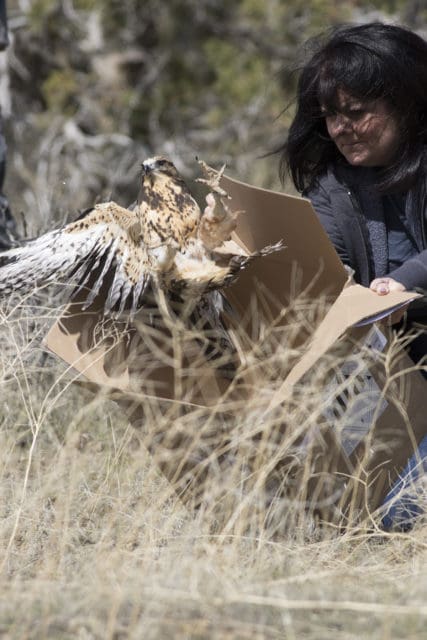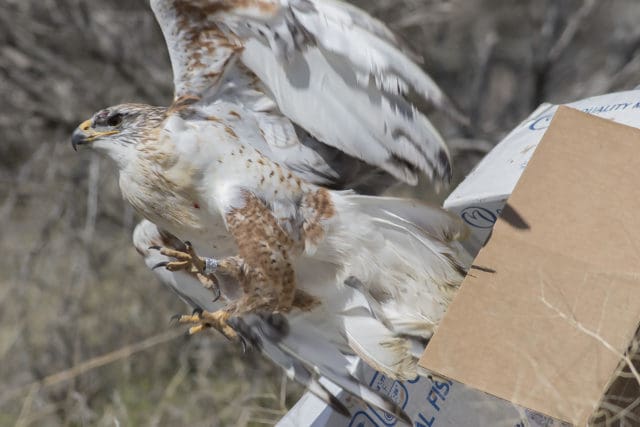Debbie Souza-Pappas, founder and director at Second Chance Wildlife Rehabilitation in Price Utah has been doing wildlife rehabilitation for 23 years now. In 2001 she started the organization Second Chance Wildlife Rehabilitation. They work with all animals allowed by the State of Utah, including birds and mammals. Over the past 23 years, they have taken in thousands of patients, they now handle 350-400 patients per year. They handle everything from birds Hit-By-Car, birds that have been blown out of nests, and birds affected by other seasonal problems.

Debbie has turned to Eagle Mountain as a place where she can release birds of prey. “It is getting more and more difficult to find good release sites and we are having to drive further and further to accomplish many of our releases,” Debbie explains. Second Chance takes in to account several key factors when they are picking a site for release, and Eagle Mountain has become one of the places they use for releasing rehabilitated birds back into the wild. Debbie continues, “I always look for appropriate habitat for release. I also take into consideration what I’m releasing and how that will play into the area I’m looking at for potential release. For example, if I know a particular area has an issue for illegal activity, such as poisonings and gunshot victims, I’m certainly not going to return the bird to that area. Adults we like to return to their territory since they have already established a territory, and most likely, have a mate. But we can’t do that every time.” As good release sites become harder to find, Debbie has this to say about Eagle Mountain. “Eagle Mountain is a great place to do releases as it’s prime habitat for many species we work with. We also have people like Shon Reed and some of his associates, that are keeping an eye on things as part of the Kestrel Project and wildlife in general.” Shon Reed is responsible for the Eagle Mountain Kestrel Project. The project is currently in it second year, and has placed Kestrel nesting boxes around the city, he is also an avid nature photographer and is always watching for birds, and working to protect their habitat. Debbie continues, “Shon educates the public there and in turn, many are realizing that the raptors take care of things may people consider pests and that poisons are not a good solution, killing indiscriminately.”
Second Chance covers more territory than any other rehabilitation organization in the State of Utah. “From the 4-Corners area in Duchesne and up through Utah County and Salt Lake as well.” As far as who does the rehabilitation work in Utah, Debbie says, “We are the ones, not the DWR, that the state uses and permits for the care of sick, orphaned and injured wildlife within the state of Utah. No one else does this work. It requires a great deal of education, training, time, and money. None of us are paid by anyone to do this so we are constantly fundraising in order to do this work. It is not a hobby. We are professionals and live, eat, and breathe this work. It’s our souls. There is NEVER a day off for a true rehabilitator. NEVER! And I wouldn’t want to do anything else.”

Delores Reid Freestone, a fellow birder, nature photographer, and a Magna resident, has enjoyed working with Second Chance, “I started out just being a birder and have taken a few birds to rehab places. This brought a whole new perspective to birding by seeing what the end result is by helping get those beautiful birds of prey back to the wild. Debbie works hard and sacrifices much so I will do what I can to make it a fully successful recovery. People should be aware of what a rehabilitation expert goes through and the cost involved.” Delores has been involved in releasing several birds back into the wild around Eagle Mountain. On March 11, 2017 she helped release a Rough legged Hawk, after it was rehabilitated after being struck by a car. “So happy to help release this Beautiful Rough legged Hawk!” She was also involved in the release of a Ferruginous Hawk, and Swainson’s Hawk on March 26th, 2017 back into the wild. Shon Reed was also a participant of these three birds release around Eagle Mountain.
Second Chance Wildlife Rehabilitation in Price Utah, works from donations received from residents. You can visit their website if you want to find out more about their organization, as well as donate to help with the rehabilitation efforts. Their website can be found at: http://wildliferehabprice.wixsite.com/2ndchance. You can also find more about the Eagle Mountain Kestrel project, including visiting their webcam by visiting this location: http://cedarvalleysentinel.com/kestrel.
The lighter bird is a Ferruginous Hawk (last photo in article), the largest hawk in the Americas, and nearly the same size as the largest on Earth.
The other two photos are of a Swainson’s Hawk, they migrate from Argentina for the winter and breed in North America.
Both species have been found to breed in Eagle Mountain. They were release back to the wild in Eagle Mountain on March 26th, 2017.
Mike Kieffer – Editor-in-Chief, Cedar Valley Sentinel
Mike Kieffer is a dynamic leader and community advocate based in Eagle Mountain, Utah. He serves as the Editor-in-Chief of the Cedar Valley Sentinel, a local publication dedicated to informing, inspiring, and elevating the Cedar Valley community through honest and accurate journalism. With a passion for fostering connections, Kieffer has made it his mission to highlight local businesses, provide reliable news, and support community development.
Beyond his editorial role, Kieffer is the owner of Lake Mountain Media, LLC, a company specializing in media and communications, and the co-owner of Quail Run Farms, which focuses on sustainable farming and community engagement. He also actively contributes to the local economy and culture as a member of the Eagle Mountain Chamber of Commerce.
Kieffer’s dedication extends to preserving and promoting the history and heritage of the Cedar Valley area. He often participates in community-centered events and media, including podcasts that explore the unique aspects of life in the region. Through his varied endeavors, he remains a steadfast advocate for the growth and enrichment of the local community.

